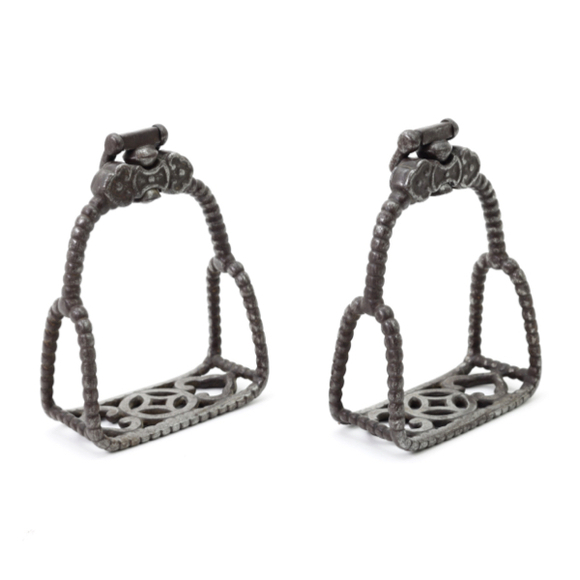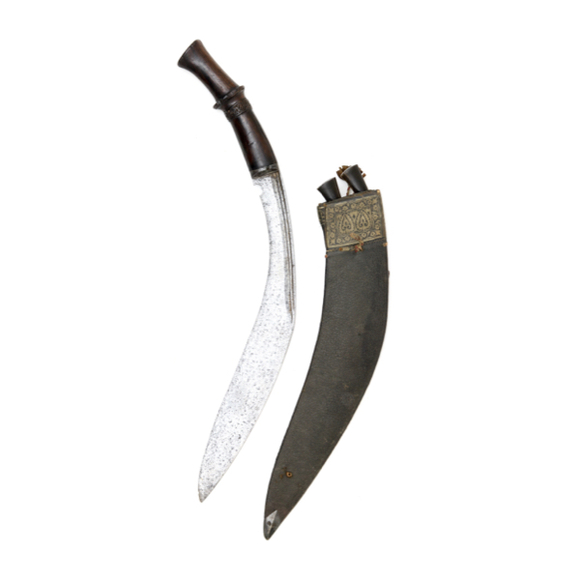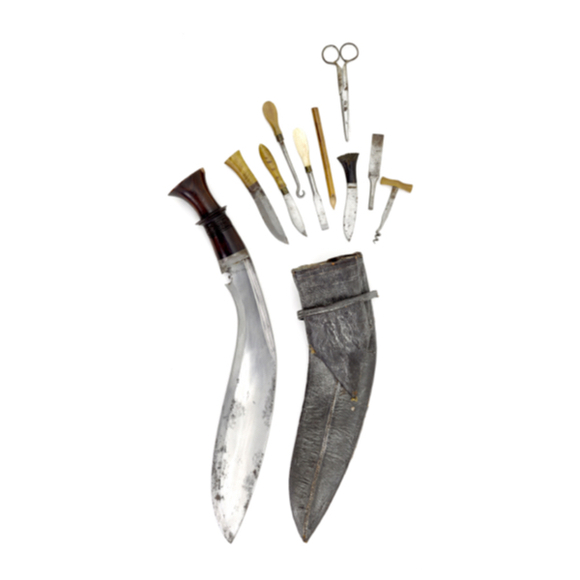Forged iron, swiveled stirrups with an entirely beaded frame and openwork platforms.

47.8 cm
35 cm
Base 15 mm
Center 13 mm
Near tip 11 mm
Base 17 mm
Center 15.5 mm
Near tip 12.5 mm
868 grams
71 mm
(From handle side of guard)
China
Iron, brass
16th - 18th century
Description
A Chinese forked mace with cast ornament in the middle of the cross guard. The ornament depicts two yazi dragon, from the mouth of each emerges one of the iron prongs. Yazi is one of the nine sons of the dragon, a wolf-like creature it is the most aggressive of dragon and is therefore often depicted on weapons.
The main rod is a rounded hectagonal cross-sections with the two facing flats being wider than the four facets pointing towards the sides. The guard's quillons are recurved and provide just enough space for a reversed grip.
Hilt is a solid full-tang construction with a facetted iron pommel forge-welded on. It was probably once covered with cotton. wrapping.
Classification
As civilians weapons, these are not very well documented in Chinese literature. They are probably a member of the family of tiějiǎn (鐵鐧) or "iron maces". Other terms used by collectors are tiěchǐ (鐵尺) or "iron rulers". There may be something to this, as the rod is exactly the size as a fairly standard sized antique Chinese ruler of which I purchased a bundle in Beijing many years ago.

Dating
Among Chinese collectors such forked maces with cast monster head in the center of the guard are thought to be Ming. I have not been able to either debunk or verify that claim, but the type of weapon must have been around for some time. It was adopted on the Ryukyu islands of Japan, and became one of the staple weapons of Okinawan martial arts. Here, a mature system is already described in 1668.1
I have however been able to find a mid 18th century woodblock print illustration of a man wearing a weapon very much like this one.

The illustration is from the woodblock edition of Huáng Qīng Zhígòng Tú "Imperial Qing Portraits of Periodical Offering", depicting all the peoples that came to bring periodic tribute to the Qing court. This particular edition dates from the 15th year of Qianlong, or 1741.
The man depicted is described as Sūlǎ guó yírén (蘇喇國夷人) or "Barbarian from Sula". The accompanying text explains that Sula is near Hui (Muslim) territory in the southwest. The weapon depicted is remarkably similar to the item described in this article. Another, full color version of the same text depicts the same man with a slightly different, bronze colored forked mace.
Ethnic minorities at the fringes of the empire were known to hold on to earlier Chinese weapon designs much longer than the Chinese in the east where fashions changed quickly.
Conclusion
An interesting Chinese mace, of the forked type which formed the inspiration for sai in Okinawan martial arts. A handy little parrying weapon that may well be one of the oldest of its type I've had through my hands so far.
Notes
1. Kanenori Sakon Matsuo; The Secret Royal Martial Arts of Ryukyu, Books on Demand, 2005. Page 81.
2. Huáng Qīng Zhígòng Tú (皇清職貢圖) or "Imperial Qing Portraits of Periodical Offering". Woodblock edition of 1741. Page 76.









With a very fine Nepalese blade, but kard-like hilt and scabbard.
Early type with very shallow notch in the blade and little flare in the pommel.
20th century military khukurī with many different tools in its back pocket.






